"Four years of football are calculated to breed in the average man more of the ingredients of success in life than almost any academic course he takes."
-- Knute Rockne
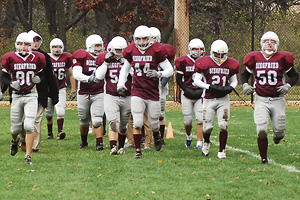
Allison Ambrose/University of Notre Dame
Wondering who these guys are? Keep reading.
SOUTH BEND, Ind. -- It's only 6 p.m., but the sun has long since set on this November day in northern Indiana. The temperature hovers in the mid-30s, but the swirling 25 mph winds make it feel more like the Arctic Circle. It's the type of weather that singes your uncovered ears and causes the rest of you to go uncomfortably numb. The type of chill that makes you long for a warm fire, or at least a warm barstool.
Yet this football team in front of you is engaged in a spirited practice under the lights, in full pads, and fully committed to hitting each other at each and every opportunity. Man, it hurts just to watch people get tackled right now. You'd think they would be taking it a little easier, in these conditions, and at this point of the season. But no, not these guys.
And as you watch the players flinging their bodies all over the practice field -- crunching block after crunching block, and crackling pop after crackling pop -- you can't help but feel a little admiration for them.
After all, these are not Charlie Weis' Fighting Irish you are watching.
No, these are the Ramblers of Siegfried Hall.
When you hear the words "Notre Dame," you probably think of college football. The Four Horsemen and Paul Hornung. Knute Rockne and Rudy.
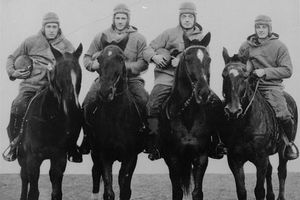
AP Photo
The Four Horsemen -- Harry Stuhldreher, Jim Crowley, Don Miller and Elmer Layden -- are just a few of Notre Dame's football legends.
That's natural. Notre Dame has won more national championships, and produced more All-Americans, than any other major college football team in the country. But the university's most unique contribution to the college football landscape is a program few people outside South Bend know about: interhall football -- an intramural tackle football league. Besides the United States Military Academy at West Point, Notre Dame is the only college in the country that offers one.
They call it "interhall" football because you play for your hall (aka dormitory) team. When you arrive as a student at Notre Dame you are randomly assigned to a particular hall that you live in, or at least remain affiliated with, for your entire time there.
"Notre Dame has never had fraternities or sororities. The halls very much take their place," said Father John Conley, the current rector of Siegfried Hall. "Students tend to make the hall their home, and the center of their campus life."
In fact, it's not uncommon for varsity football players to give a shout-out to their hall at the pep rallies on the nights before home games. And when the basketball team's starting lineup is introduced before a home game, the public-address announcer includes which hall each player hails from.
Notre Dame has interhall leagues in 17 different sports. But it should come as no surprise that at a school synonymous with college football, the men's and women's interhall football leagues are the most popular.
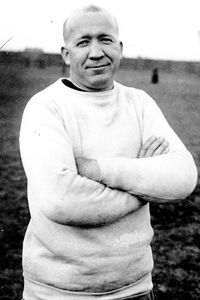
AP Photos
Legendary Notre Dame coach Knute Rockne was a big proponent of interhall football.
The women play flag football -- although "they'd wear the pads if they could," Father Conley said. On the other hand, the men play full-contact, with full pads -- the same game most of them played in high school. The same game many of us got to play in high school. And the same game very few of us ever got to play afterward.
"After high school, I thought, 'Man, I'm never gonna get to play football again'," said Siegfried offensive/defensive lineman Pat McMaster. "This is such an awesome opportunity."
The interhall football tradition at Notre Dame goes back a long way -- the term "interhall football" first appeared in the Scholastic (the Notre Dame student magazine) on Oct. 24, 1885, although the game was played more like rugby back then. One of the big reasons the program is still alive today is Knute Rockne himself. Rockne believed a person could learn a great deal from playing the game of football, and strongly encouraged students to participate. He also established a hand-me-down program whereby the varsity football team would donate uniforms and equipment to the interhall teams.
That spirit of sharing continues. This year the varsity football team donated home and away practice uniforms to each hall, so the interhall players wouldn't have to wear their game jerseys during practices.
But as you can imagine, many more resources are necessary to keep an intramural tackle football program afloat. Insurance coverage is costly. The university's Office of Risk Management handles that, and issues a strict set of guidelines for student participation. Each potential interhall player must fill out a detailed student health history form, and be checked out by a physician if there are any red flags. Also, every player must watch a safety DVD, "Prevent Paralysis: Don't Hit With Your Head," before the season.
Equipment is also a major expense. The estimated cost to outfit each player is $265, which includes a helmet, shoulder pads, hip pads, thigh pads and knee pads.
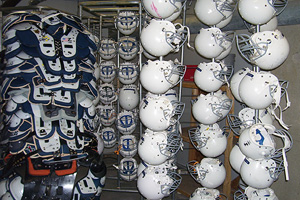
Kieran Darcy
Notre Dame's recreation sports department has a small room in the bowels of Notre Dame Stadium where they store the interhall football equipment.
"It's probably a 20- to 25,000-dollar cost to run that program [each year]," said Rich O'Leary, the school's director of intramurals and club sports. "If we tried to start it today, we probably couldn't do it. But because historically it's been so successful, the athletic department and the administration have continued to put funding towards it."
This year's men's interhall football league consisted of 15 teams, split into three divisions. Each team played four regular-season games from late September through early November. Then the top two teams in each division, plus two wild-card teams, advanced to the playoffs.
Although it's just an intramural sport, interhall football is taken
very seriously on campus. The school paper, the Notre Dame Observer, covers all the games. Lots of fans come out to watch. The competition on the field is fierce, with each hall's collective pride on the line. Oh, and there's one more thing on the line, too: The championship game takes place at Notre Dame Stadium.
Every year, on the Sunday after the last varsity home game of the season, two intramural teams get to play in one of the most historic buildings in sports.
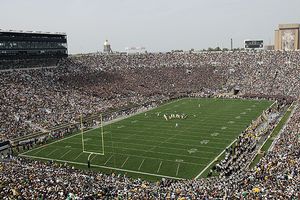
Chris Chambers/Getty Images
Can you imagine getting to play an intramural game in this stadium?
"Second only to graduating, my goal has been to play in that stadium," McMaster said. "I'd do anything to get there."
Siegfried has generally fielded successful interhall football teams over the years. But coming into this season, it hadn't made the championship game since 2003. The past two years they've fallen one rung short, losing a heartbreaker in the semifinals. And this year's Siegfried squad was dominated by seniors, meaning the pressure was on.
This was their last chance.
That's why the Ramblers were out there on that frigid Thursday evening last week, working their tails off. It was their last practice before the semifinals -- perhaps the last practice of those seniors' careers. They stayed on the field for well over two hours. And at the end of practice, when they huddled up, McMaster -- the team's lead vocalist, so to speak -- had a few words to say.
Actually, he didn't say them so much as scream them.
"This happened to me twice before! And it's not gonna happen to me again!
"WE'RE GOING TO THE STADIUM!"
Siegfried senior tight end/linebacker Kevin Kelly thought his football career was almost certainly over when he decided to attend Notre Dame four years ago. He'd had a nice high school football career in Michigan, and was recruited by a few Division III schools. But he chose to go to Notre Dame instead, for academic reasons.

Jessica Lee/University of Notre Dame
Kevin Kelly is Siegfried's captain, and one if its top players this season.
He was pleasantly surprised when he heard about interhall football.
"I had no clue about interhall," Kelly said. "I'd thought a little about trying to walk on, maybe do the Rudy thing, so you could say at least that you were part of the team. But when you realize how big a deal the interhall thing is, I said, 'You know, maybe I'll just do that instead.'"
But first he had to try out. The maximum amount of players on each men's interhall football team is 24, and most halls have far more students than that interested in playing. Siegfried had about 50 students try out this year.
The teams generally practice three times a week -- a fairly significant time commitment, though not nearly as time-consuming as being a member of the varsity, said Siegfried's Dex Cure. He should know -- he was a fullback on the varsity for two years before leaving the program and joining the Siegfried team this season. "There's much less time commitment [in interhall football], but just as much fun, just as much camaraderie," Cure said. "You live with these guys; you get real close to them, they're friends for your whole life. It's very special."
But don't get the wrong idea. Interhall football might take up less time, but interhall players can be just as intense. Over the years, interhall players have gone to extraordinary lengths to try to gain an edge over their opponents. For instance, on a number of occasions, teams have actually asked for permission to use headsets, in order to communicate their play calls more efficiently. The administration decided that was going a tad too far for intramurals.
But that's not O'Leary's favorite story. "One guy had the means to buy video equipment, and he wanted to set up scaffolding by the practice fields so he could videotape the opposing teams from above," O'Leary said. "We told him we weren't going to get into doing that."

Allison Ambrose/University of Notre Dame
The interhall games are very physical, and the players do get banged up.
The staff at St. Joseph's Hospital in South Bend are also well aware of the intensity of Notre Dame interhall football. The games take place on Sundays, and St. Joseph's has grown to expect a new patient or two on fall Sunday afternoons.
But injuries are a part of the game. At least, they're a part of the
real game, the game we're all accustomed to watching on Saturdays and Sundays. Football is violent -- and whether you like it or not, that's what makes the game unique.
It's also what fosters such a special bond between football teammates. Football players put their bodies on the line for one another. An offensive lineman endures blow after blow to protect his quarterback. A fullback throws a block to clear space for his running back. A wide receiver lays out in mid-air to haul in a pass, knowing he's risking life and limb in the process.
No wonder the Siegfried team is as tight as it is, eating breakfast together the mornings before games, and often eating dinner together after practices.
"Tackle football is totally different," McMaster said. "It's the real thing. That's what makes [interhall football] so special."
Notre Dame's varsity football players tend to show great respect for their interhall contemporaries, too. Sunday happens to be the varsity team's day off, and it's not uncommon for varsity players to come out and cheer on their halls.
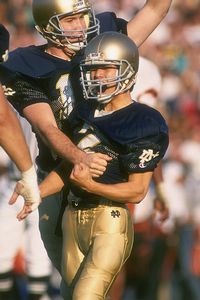
Jonathan Daniel/Getty Images
Reggie Ho went from interhall player to varsity hero in 1988.
It's also not uncommon for members of the varsity coaching staff to stop by and catch some interhall action. After all, they've found some diamonds in the rough over the years. Pat Heenan, who began his Notre Dame career playing for Dillon Hall, ended up starting at end for the 1959 Fighting Irish, and even played one season for the Washington Redskins. Reggie Ho was an interhall kicker before he kicked four field goals, including the game-winner, to lead Notre Dame to a 19-17 victory over Michigan in 1988, the school's last national championship season.
Siegfried Hall just lost its kicker to the varsity a few weeks ago. David Ruffer, a sophomore in his first year at Notre Dame after transferring from William & Mary, didn't even play high school football, but made the Siegfried interhall team this September as a wide receiver and kicker. And when Ruffer started booming 40-yard-plus field goals between the uprights, a buzz started building around campus.
Meanwhile, the starting kicker on the varsity, Brandon Walker, had gotten off to a rough start, connecting on just two of his first eight field goal attempts.
The varsity coaching staff caught wind of Ruffer -- not a big surprise, considering Weis was a player/coach for Flanner Hall back in the 1970s. The special-teams coach, Brian Polian, called Ruffer and asked him to come down to the stadium for a tryout. Ruffer performed well enough to be added to the roster.
Ruffer said it's been exciting being a member of the varsity team. But there was one catch.
"I definitely miss playing with these [Siegfried] guys," he said. "They're the guys I live with; they're my buddies. It's kind of a bummer, not getting to play interhall anymore."
Sunday afternoon was even colder than the Thursday evening before. But the brisk conditions seemed to have little or no effect on the Siegfried players, one win away from playing on the stage they'd dreamed about for so long.

Allison Ambrose/University of Notre Dame
Marcus Young has been a key cog in Siegfried's offensive attack this season.
This first semifinal promised to feature a contrast in styles. Siegfried relies on a strong running game and a stalwart defense -- the Ramblers had not allowed a touchdown all season. Meanwhile, their opponent, Morrissey Hall, does most of its damage in the air, via the strong arm of senior quarterback Joe McBrayer.
Two years ago in the semis, McBrayer led Morrissey to a win over Siegfried and a trip to The House That Rockne Built. Now he was hoping to earn a second chance to play on that hallowed ground.
The privilege of getting to play in Notre Dame Stadium cannot be underestimated. It is a
huge deal, especially for anyone familiar with Fighting Irish history. It is arguably the most famous football stadium in America. Opened in 1930, it has hosted over 200 consecutive sellouts, and been witness to so many of college football's best and brightest over the years. And with its views of Touchdown Jesus and Notre Dame's famed golden dome, it truly feels like a holy place.
"That's the biggest deal of this whole thing," Kevin Kelly said. "The fact that if you win, you get to play in that stadium -- that's something that most people never get to experience."
But first, Siegfried had one more game to win. With just a few minutes remaining before the start, Siegfried coach P.J. Zimmer gathered his charges in one corner of the field for a few final instructions. Zimmer, a recent graduate of Notre Dame's M.B.A program, played only one year of high school football. He has barely any football coaching experience. But he volunteers, along with a couple other Notre Dame alums, Tom Valenti and Rob Kelly, to help coach the Siegfried team -- three more guys who simply wanted to be a part of all this.
"They're a great group of guys," Zimmer said of his team. "I mean, these guys are in college, they're adults. They don't have to listen to what we tell them to do. They probably know more about football than we do. But they really follow direction. They put in a lot of time and effort. … It's turned into a pretty good family."
The rules of interhall football are a little different. Each game consists of four 12-minute quarters, with a running clock -- so the games move rather quickly, usually only taking about an hour to complete. Also, there are no kickoffs -- at the beginning of each half, and following each score, the team with the ball begins at its own 35-yard line.
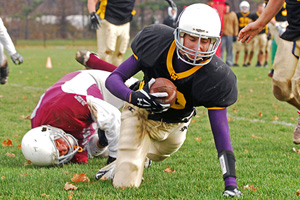
Jessica Lee/University of Notre Dame
Siegfried's defense put a lot of pressure on Morrissey quarterback Joe McBrayer.
Siegfried had the first offensive possession of the game, and the Ramblers wasted little time, marching right down the field. Zimmer keeps it simple, using just a handful of plays -- some simple pass patterns and your basic running sets: sweeps, counters, draws. That's all they needed, with quarterback Max Young eventually carrying the ball into the end zone himself, giving Siegfried a 7-0 lead.
On his first possession, however, McBrayer quickly completed two long passes to lead Morrissey deep into Siegfried territory. Then, out of a shotgun set, and despite getting hit as he threw, McBrayer connected with receiver Carl Anderson to even the score -- the first touchdown Siegfried's defense had surrendered all season.
Except Morrissey
didn't even the score, after all. Siegfried blocked the extra-point attempt, so the Ramblers retained a 7-6 lead.
The score remained 7-6 until the fourth quarter. Midway through the quarter, Siegfried missed a long field goal try, so Morrissey took over with decent field position. The momentum felt like it might be turning Morrissey's way one more time. But the Ramblers' defensive unit was up to the challenge. They sacked McBrayer for a big loss, then forced the Manorites into holding and intentional-grounding penalties that pinned them deep in their own territory. Morrissey was forced to punt from there, giving Siegfried excellent field position.
And Siegfried capitalized. Max Young completed a pass in the flat to Kevin Kelly, who turned and rumbled down the field, breaking tackles a la Mike Alstott, on his way to a huge gain. And then running back Marcus Young finished the drive, taking it to the house to give Siegfried a 14-6 lead.
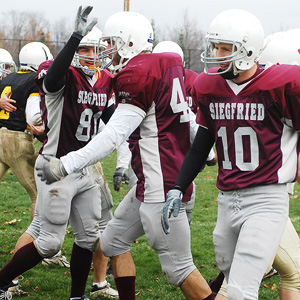
Allison Ambrose/University of Notre Dame
The Siegfried players were all smiles, knowing where their next game would be.
On the very next play, McBrayer threw the final pass of his interhall career -- an interception, hauled in by Siegfried's Matt Meinert. A couple of kneel-downs later and the teams were shaking hands at midfield.
Coach Zimmer quickly gathered his team in the corner of the field again, telling them how proud he was of them. He reminded them that they still had one more game to win. But one glance at the Siegfried players' faces -- each seemingly plastered with the same ear-to-ear grin -- told you everything you needed to know.
"On three, everybody!" someone in the huddle shouted. Then everyone joined in: "One, two, three: STADIUM!"
The Siegfried Ramblers were one win away from a championship.
But the truth is, they'd already won.
Kieran Darcy is an editor for Page 2. He can be reached at kieran.d.darcy@espn3.com.












Comments
You must be signed in to post a comment